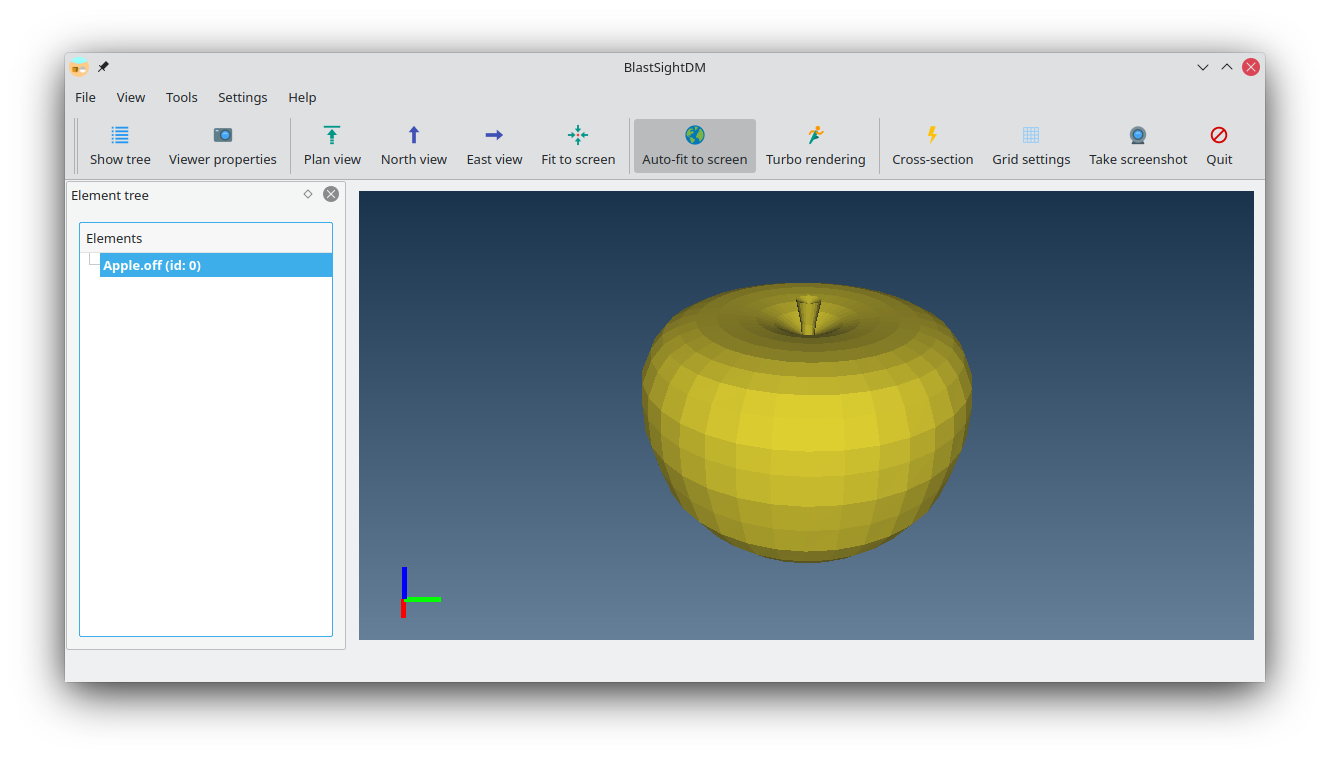# BlastSight
BlastSight is a 3D visualization software designed to aid in Mining research.

## Installation
You can install BlastSight with the following command:
`pip install blastsight`
BlastSight requires the Python implementation of Qt5, and uses
`qtpy` to abstract backends.
This means that you need to install a backend yourself, using either of these commands:
- `pip install pyqt5`
- `pip install pyside2`
Both backends should work, but if you find errors using one backend, try with the other!
You can read the documentation from [qtpy](https://github.com/spyder-ide/qtpy)
for more information.
## Usage
Implemented in Python 3.7 and qtpy, it's useful as a library and as an application,
so you can use it as a viewer, or integrate it to an application you're developing.
### Application Mode
Start the application with `python -m blastsight`.
From there you can load elements with File > Load [element].
More information in Help > Help.
### Integrable Mode
You can embed BlastSight's viewer within your application.
Check the following code and adapt it to your needs.
```python
from qtpy.QtWidgets import QApplication
from qtpy.QtWidgets import QWidget
from qtpy.QtWidgets import QGridLayout
from blastsight.view.integrableviewer import IntegrableViewer
class EmbeddedViewer(QWidget):
def __init__(self, parent=None):
super().__init__(parent)
self.setWindowTitle('EmbeddedViewer')
self.resize(800, 600)
self.viewer = IntegrableViewer(self)
self.layout = QGridLayout(self)
self.layout.addWidget(self.viewer, 0, 0, 1, 1)
if __name__ == '__main__':
app = QApplication([])
embedded = EmbeddedViewer()
embedded.show()
app.exec_()
```
### Viewer Mode
You can also use BlastSight as a simple viewer when you write your own script.
Insert the following lines in your script:
```python
from blastsight.view.viewer import Viewer
viewer = Viewer()
# Your code
viewer.show()
```
## Basic API
The following methods can be used to render your elements directly.
Keep in mind that these methods receive their arguments as *kwargs*, they're not positional.
```python
# Mesh
viewer.mesh(x: list, y: list, z: list, indices: list, color: list, alpha: float, wireframe: bool, highlight: bool)
# Blocks
viewer.blocks(x: list, y: list, z: list, block_size: list, values: list, vmin: float, vmax: float, colormap: str)
# Points
viewer.points(x: list, y: list, z: list, point_size: float, values: list, vmin: float, vmax: float, colormap: str)
# Lines
viewer.lines(x: list, y: list, z: list, color: list, loop: bool)
# Tubes
viewer.tubes(x: list, y: list, z: list, color: list, loop: bool, radius: float, resolution: int)
```
Notes:
* An additional 'name' *kwargs* can be used to give each element a name.
* For **every** element, you can replace (x, y, z) with *vertices*, which is a list
of positions, where each position is a list of (x, y, z).
* For **meshes**, the *indices* argument is a list of index, where index is a list of
(i1, i2, i3).
* For **blocks** and **points** you can replace (values, vmin, vmax) with *color*,
which is a list of colors for each position, where each color is a list of (r, g, b),
between 0.0 and 1.0.
## Examples
BlastSight comes with a folder of examples that show what you can do with it.
It's recommended to check `examples/demo.py` in https://github.com/gsanhueza/BlastSight/
to develop an idea of how to use this software.




